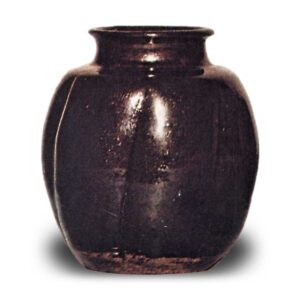
Me refers to the carving marks made by the scraping or stroking of the spatula. Since the spatula was originally a tool used for shaping, it is usually not very welcome to see the tool marks left on finished vessels, as they are not very pleasing to the eye. Therefore, except for the occasional unintentionally left spatula marks on Chinese and European ceramics, there are almost no spatula marks on finished wares. However, in Japan, the use of eyes as a decorative element in matcha bowls, tea containers, water jars, flower vases, and so on, is common. This is a testament to the uniqueness of the Japanese taste. The use of spatula eyes is effective on Seto, Tokoname, Iga, Shigaraki, Bizen, Karatsu, Raku ware, and Namban-style pottery, and is rarely used on elegant and refined works of Takatori, Zensho, and other styles. The eyes have a kind of decorative effect as a landscape that gives a sense of power, and express simple lightness and bold strength, so they are not suitable for elegant wares with beautifully changing glaze colors. Among the famous tea caddies in existence today, the Daimonokara karamono tea caddies Yokota hagashu was the first to use spatula-me as a decorative element. Sen no Rikyu was the first to consciously use spatula as a means of decoration. At the time, the tea ceremony was a period of wabicha, a Zen-style tea ceremony that emphasized a wabi-tea taste with a dry and tepid taste in response to the bold and unrestrained spirit of the Warring States period, so the use of simple, well-cut spatulas or deeply carved spatulas was most common, both bold and simple. The famous tea-entering Jizo is a representative example of this style. In the Edo period (1603-1867), the tea ceremony style became more luxurious and fashionable with the maturing of the times, and the eyes made at that time tended to be elaborate and delicate in beauty and to show off their spirit. Most of them were made with thin, shallow, rounded spatula eyes that were carved in large numbers and in a highly patterned style. There are two types of spatula: flat or cut spatulas that look as if they were cut by force, and stripes that have more of a sculptural intent. There are also vertical, horizontal, and diagonal types of spatula in terms of direction. In “Chawan,” No. 24, Segawa Masashi’s spatula is described as having a shoulder impulse.



